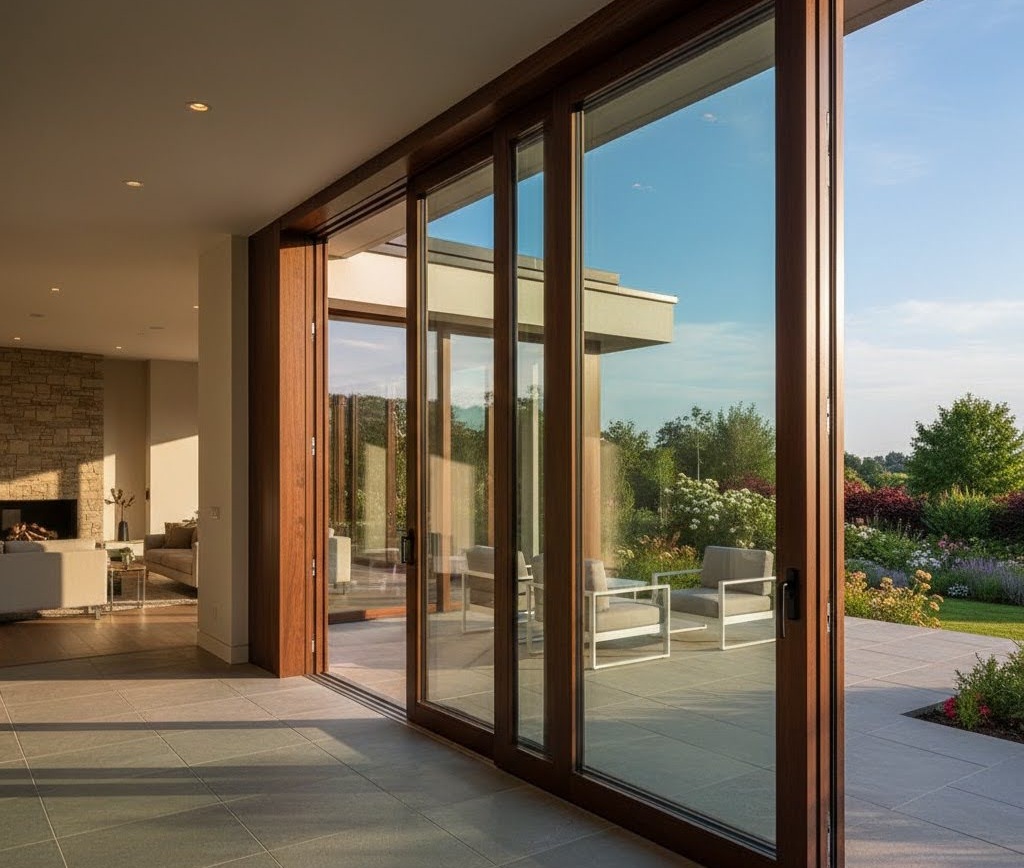Vinyl vs Aluminum vs Fiberglass Sliding Door: Which One is Better for Toronto

Choosing a sliding door in Toronto isn’t simple. Here winters bite, summers bake, and wind off Lake tests frames and seals. You also have to keep in mind the budget matter; so does the look.
In this blog, you’ll figure out what's worth it: Vinyl, Aluminum, Fiberglass. We compare them for GTA homes, townhouses, and condos.
Quick rule of thumb:
Want the lowest cost with solid comfort? Consider Vinyl.
Want a modern, slim look and large glass panels? Consider Thermally broken Aluminum.
Want a long life and stable performance in all seasons? Consider Fiberglass.
Toronto's Climate And Codes
As you already know, winters are cold in Toronto, summers get hot, and the swings are really hard.
More expansion/contraction cycles = more stress on frames, rollers, and seals.
Lake wind raises structural demands on large sliding units.
What does that mean for sliding doors?
Thermal movement is important. Because frames that expand or shrink too much can put stress on corners and glass seals over time.
Dark-colored doors, especially black ones, can get very hot under the July sun. So it’s essential to pair them with high-quality finishes and the right glass to manage heat and keep your home comfortable.
Energy Expectations
Look for Low-E coatings, argon fill, and warm-edge spacers.
Low-E: Thin coating that reflects heat.
Argon: Gas between panes slows heat transfer.
Warm-edge spacer: Reduces edge-of-glass heat loss and condensation.
Double-pane is enough for many homes. Triple-pane helps in noisy streets, north-facing rooms, or where comfort is critical.
Note: Triple-pane doors are heavier; hardware and tracks must support the weight.
Typical GTA Housing & Door Choices
’50s–’70s brick bungalows/semi: Vinyl sliding doors provide the best value. Fiberglass are best for front-facing or patio upgrades.
’80s–2000s suburbs: Vinyl or Fiberglass. Match trims, siding, or stucco transitions.
Downtown condos/lofts: Often Aluminum or Fiberglass. Slim profiles, large glass panels.
Reminder: Condo boards may require specific exterior colors, finishes, or grids.
Materials Basics: What & Why
Aluminum Sliding Doors
Aluminum gives the most modern look to your homes. Aluminum frames use extruded metal profiles separated by a thermal break to reduce heat transfer.
Why it matters: High strength allows slim frames and large glass panels without extra reinforcement.
Thermal movement: ~23 × 10⁻⁶/°C (moderate)
Upsides: Minimalist look, largest panel sizes, crisp corners, premium finishes.
Watch-outs: Must be thermally broken for Toronto winters. Frames feel cooler to the touch; glass packages do much of the energy work.
Best for: Modern designs, tall or wide sliding doors, corner configurations, and slim sightlines.
Vinyl Sliding Doors

Vinyl frames use rigid PVC with multi-chamber profiles for insulation, drainage, and reinforcement. Steel or fiberglass reinforcement keeps large/dark units stable.
Thermal movement: ~70–100 × 10⁻⁶/°C (higher)
Upsides: Best price-to-performance ratio, low maintenance, naturally warm frame.
Watch-outs: Thicker frames, dark large panels may expand in summer. Use cap-stock exteriors + reinforcement.
Best for: Value-driven replacements in detached or semi-detached homes.
Fiberglass Sliding Doors

Fiberglass frames are made from glass fibers set in resin, pultruded into rigid profiles. Expansion rate is close to glass (~5–10 × 10⁻⁶/°C), reducing stress on seals and corners.
Upsides: Strong, stable, energy-efficient, paintable, long service life, minimal distortion.
Watch-outs: More expensive than Vinyl, usually not as slim as Aluminum.
Best for: “Install once, forget it” buyers seeking durability and stable performance through Toronto’s temperature swings.
Performance Comparison
Factor | Aluminum | Vinyl | Fiberglass |
|---|---|---|---|
Energy potential | Good (with glass) | Very good | Very good–Excellen |
Sightlines | Slimmest | Thick | Slim–Moderate |
Max panel sizes | Largest | Moderate (reinforced) | Large |
Structural strength | Strongest | Good (reinforced) | Strong |
Maintenance | Low | Lowest | Low (paintable) |
Finish options | Best | Limited (cap-stock) | Paintable |
Noise | Excellent | Excellent | Excellent |
Relative cost | $$–$$$ | $ | $$ |
Design & Aesthetics
Sightlines
Aluminum sliding doors have thin frames for a clean, modern look.
Fiberglass doors have slim to moderate frames for a quiet, refined appearance.
Vinyl doors have thicker frames that suit traditional styles.
Style compatibility:
Modern/minimal/big glass: Aluminum first, Fiberglass alternative.
Traditional bungalows: Vinyl for value, Fiberglass for sharp profile.
Condos/lofts: Aluminum or Fiberglass to match façade.
Color & finish
Black trend possible for all.
Aluminum: powder-coat or anodized finish.
Fiberglass: paintable to any color.
Vinyl: cap-stock black or dark for UV stability.
Hardware & operation
Aluminum: premium feel with crisp operation
Fiberglass: solid and quiet performance
Vinyl: widest range of cost-effective hardware options
Glare, fade, and comfort
Use Low-E glass to control daylight and reduce unwanted solar heat gain.
Select quality glass to maintain interior color neutrality and protect furnishings.
Dark frame colors can absorb more heat, so pair them with proper glass to minimize fading.
Consider frame color and glass combination to ensure year-round comfort and energy efficiency.
Size, Spans & Configurations
Big glass is stunning but size is limited by wind, weight, and hardware.
Aluminum: supports largest panels.
Fiberglass: large panels, step below Aluminum.
Vinyl: moderate panels; reinforcement needed for big units.
Excess flex = poor sealing, hard operation, water/air leaks. Stiff frames keep rollers, gaskets, and hardware happy.
Smart configurations:
Big fixed panel + flanking sliding panel for ventilation
Transoms or sidelites for height, operable panels reasonable
Corner systems: Aluminum enables post-less or butt-glazed looks
Retrofit vs Full-frame
Retrofit (insert): Faster, preserves interiors, less disruption, slightly less visible glass.
Full-frame: Best for sealing and long-term performance, resets flashing, sill pans, insulation, and corrects hidden damage.
Full-frame installs usually cost about 20 to 30 percent more than retrofits, but they give you a cleaner finish and better long-term energy performance.
Cost & Lifetime Value
When you’re comparing sliding doors, it helps to think beyond just the sticker price. The frame material you choose (vinyl, fiberglass, or aluminum) affects not only the upfront cost, but also long-term comfort, energy use, and how long the door will last.
Installed cost (relative)
Vinyl generally gives the best value for a typical home, while fiberglass and aluminum sit higher on the price ladder:
Vinyl: Lowest upfront cost and excellent value for most homes, without sacrificing comfort.
Fiberglass: Usually about 20–40% more than vinyl, but highly durable and dimensionally stable over time.
Aluminum: Often 30–60% higher than vinyl, with prices climbing further for large panels or premium finishes.
What drives the price up?
Certain design and performance choices add to the total installed cost:
Oversized sliding doors
Triple-pane glass
Laminated or acoustic IGUs
Custom exterior/interior colors
Designer hardware
Full-frame installation instead of simple retrofit
Lifetime energy & comfort
Spending a bit more on the right glass and frame can pay you back in comfort and energy savings:
Better glass + warmer frames reduce winter heat loss and help lower energy bills.
Replacing old, leaky doors with Low-E, argon-filled glass noticeably improves indoor comfort and cuts down on drafts.
Maintenance needs
All three materials are relatively low-maintenance, but they differ slightly in what they need over time:
Vinyl: Very easy to care for; usually just needs periodic washing.
Fiberglass: Factory-coated for long-lasting durability and can be repainted if you ever want a new look.
Aluminum: Benefits from regular washing and occasional checks of the finish to keep it looking sharp.
Expected service life
Each material offers a long service life, with some differences in performance under harsh sun and weather:
Vinyl: About 20–30+ years. Dark colors or intense sun exposure can cause extra expansion unless the frame is reinforced.
Fiberglass: Around 30–40+ years, with very low expansion, which helps reduce stress on corners and seals.
Aluminum (thermally broken): Roughly 30–50+ years, depending on finish quality and exposure conditions.
Lead times
If timing matters, lead times can influence your choice:
Vinyl: Typically the quickest, thanks to standard sizes and wide availability.
Fiberglass: Mid-range lead time; factory-painted colors may add a bit more time.
Aluminum: Often the longest wait, especially for custom colors, oversized panels, or specialized hardware.
FAQs
Are aluminum sliding doors too cold for Toronto winters?
Not if thermally broken + Low-E + argon + warm-edge spacers. Frames feel cooler, but energy efficiency meets targets.
Do black vinyl doors warp or fade?
Quality cap-stock resists UV/heat. Large/dark units may need reinforcement. Avoid cheap painted black vinyl.
Is triple-pane necessary?
Double-pane Low-E + argon works for most. Triple-pane helps for noise, comfort, or north-facing rooms.
Can I mix materials in one home?
Yes. Many choose Fiberglass/Aluminum on street-facing or large openings, Vinyl elsewhere. Match colors/profiles for consistency.
Winter installation okay?
Yes. Proper sealants, tape/flashing, foam, and indoor temperature control matter more than season.
How to prevent condensation?
Use warm-edge spacers, choose warmer frames (Vinyl/Fiberglass), control indoor humidity, keep blinds slightly open.
Which gives the best resale appeal?
Aluminum = modern look, Fiberglass = longevity, Vinyl = value. Right glass package enhances all three












